Abstract
Digital-based artificial neural network (ANN) machine learning is harnessed to reduce fiber nonlinearities, for the first time in ultra-spectrally-efficient optical fast orthogonal frequency division multiplexed (Fast-OFDM) signals. The proposed ANN design is of low computational load and is compared to the benchmark inverse Volterra-series transfer function (IVSTF)-based nonlinearity compensator. The two aforementioned schemes are compared for long-haul single-mode-fiber-based links at 9.69 Gb/s direct-detected optical Fast-OFDM signals. It is shown that an 80 km extension in transmission-reach is feasible when using ANN compared to IVSTF. This occurs because ANN can tackle stochastic nonlinear impairments, such as parametric noise amplification. Using ANN, the dynamic parameters requirements of the sub-ranging quantizers can also be relaxed compared to linear equalization, such as the reduction of the optimum clipping ratio and quantization bits by 2 dB and 2-bits, respectively, and by 2 dB and 2 bits when compared to the IVTSF equalizer.
1. Introduction
As one of the most dominant high spectral-efficiency methods, optical-orthogonal frequency division multiplexing (O-OFDM) can virtually eliminate the interference among received symbols induced by fiber dispersion and the effect of random polarization rotation [1]. In OFDM equally MHz-spaced parallel subcarriers are used to form low capacity data transmission signals [2]. However, Rodrigues and Darwazeh recently proposed an alternative ultra-high spectral-efficient scheme, the Fast-OFDM [3], which harnesses the compression properties of Inverse Fast Cosine Transform (IFCT). In Fast-OFDM the frequency spacing between sub-carriers is considerably decreased, resulting in increased bandwidth efficiency compared to the traditional O-OFDM. This occurs because Fast-OFDM uses only half of the sub-carrier spacing [3]. Though, sub-MHz sub-carrier spacing produces significant distortion in phase-modulated signals, thus it is essential to apply single-dimensional modulation formats such as amplitude shifted-keying (ASK) [3]. IFCT-based optical Fast-OFDM has been previously demonstrated for long-haul coherent optical double-side band signals [4,5]. Furthermore, direct-detected optical Fast-OFDM was employed for cost-sensitive local networks that make use of multimode fiber links [6], due to the high cost-efficiency of the technique [5]. However, similarly to conventional O-OFDM, the Fast-OFDM signals also suffer from a high peak-to-average power ratio resulting in similar transmission performance with O-OFDM under the same signal capacity [6]. In the same work from Giacoumidis et al. [6], the dynamic parameters requirements of the sub-ranging quantizers (well-identified as digital-to-analogue and analogue-to-digital converters, DACs/ADCs [7]) involved in optical Fast-OFDM signals were also analyzed as a proof-of-concept for future-proof real-time implementation. On the other hand, while linear equalization has been an easy task for both OFDM and Fast-OFDM signals, fiber-induced nonlinear distortion compensation has not been properly addressed in optical Fast-OFDM. In traditional O-OFDM, several digital signal processing (DSP) techniques for mitigation of fiber nonlinearities have been proposed, such as the digital back propagation (DBP) [8], the inverse Volterra-series transfer function (IVSTF) [9], and hybrid pre- and post-nonlinearity compensators [10,11]. In DBP the equalizer attempts to reverse the channel non-linear effects, where the SMF channel is thoroughly and extensively modelled, thereafter, the received signals are digitally back-propagated over the modelled channel with the help of the split-step Fourier (SSF) operations at a very small distances may be 40 FFT/IFFT operations per span; which makes this method impractical and computationally expensive for real-time applications as there are a huge number of computation steps [12,13]. On the other hand, The IVSTF algorithm was presented in order to reduce the complexity of digital back-propagation (DBP); this removed the necessity for the split-step Fourier (SSF) method, which is computationally incompetent. The VSTF offers an analytical tool for expressing the fiber non-linear effects by similarly constructing the inverse channel based on IVSTF depending upon the number of fiber spans not the fiber length as in DBP; which significantly reduces computational complexity compared to DBP [12,13,14,15]. Moreover, IVSTF has shown marginal signal quality-factor improvement for coherent O-OFDM using 16-quadrature amplitude modulated (16-QAM) sub-carriers but at lower DSP computational effort [11]. Very recently, artificial neural network (ANN), which is a mimic of the conceptual and behavioral nature of the biological networks neural networks, have proven abilities and have been applied to various fields such as, competitive learning [16], finance [17], control system [18], energy management [19], and telecommunications where it has been recently used as an equalizer for coherent O-OFDM signals revealing promising results for long-haul links [14].
Due to the very low frequency spacing between sub-carriers, Fast-OFDM signals suffer more from inter-carrier interference compared to the conventional O-OFDM [3,15], consequently, the importance of realizing an equalizer to mitigate nonlinear impairments in optical Fast-OFDM is much higher. An attempt to tackle nonlinearities in optical Fast-OFDM systems was made via a Wiener-Hammerstein electrical equalizer, with however marginal performance improvement [20]. Unfortunately, the use of ANN nor IVSTF has not been reported yet, therefore in this work, for the first time, a low-complex ANN-based machine learning NLE is numerically demonstrated in low-cost intensity-modulated and directed-detected optical Fast-OFDM links using a standard single-mode fiber (SMF) as a transmission medium. A comparison is also made with the deterministic IVSTF which is also implemented for the first time in optical Fast-OFDM. The paper is organized as follows: Section 2 shows the linear equalization performance of the direct-detected-based optical Fast-OFDM system over additive white Gaussian noise (AWGN). In Section 3, there are details on the adopted ANN algorithm and IVSTF for optical Fast-OFDM signals. In Section 4, ANN is tested over an SMF-link, while in Section 5, a comparison between ANN and IVSTF is conducted for Fast-OFDM signals over SMF, considering the impact of key DAC/ADC parameters when compared to linear equalization. Thereafter in Section 6, a detailed computational complexity analysis of the ANN-NLE and IVSTF-NLE is conducted in terms of number of subcarriers for different system parameter is discussed. Finally, the paper is concluded in Section 7.
2. Impact of Directed-Detected Optical Fast-OFDM Signals over AWGN Using Linear Equalization
For our numerical simulation, the direct-detected optical Fast-OFDM transceiver design is similar to [6], using 64 sub-carriers and ASK formats for modulation with 4, 8, and 16 amplitude levels [6]. The adopted sampling rate was taken at 6.25 GS/s, resulting in sub-carrier frequency bandwidth of about 98 MHz and a length per symbol of 12.8 ns, out of which 3.2 ns were wasted by the insertion of a cyclic prefix (CP) to avoid interference among symbols during transmission.
In Figure 1, the optical Fast-OFDM modem performance over an AGWN channel is illustrated in terms of optical signal-to-noise ratio (OSNR) at 0.1 nm without using any form of nonlinear equalization. In Figure 1, the DAC/ADC clipping noise (or ratio) and quantization bits were isolated to investigate the true impact of OSNR on the developed optical Fast-OFDM modem. From Figure 1, it is noticed that for a fixed bit-error-rate (BER) value, a higher order modulation format needs higher OSNR. More specifically, the OSNR is required for achieving a BER of 10−3 when using 4-ASK is 18.5 dB, 25.5 dB for 8-ASK, and 36 dB for 16-ASK. It should be noted that simulated results agree very well with the analytical results reported in [6], which confirms the validity of the used model.
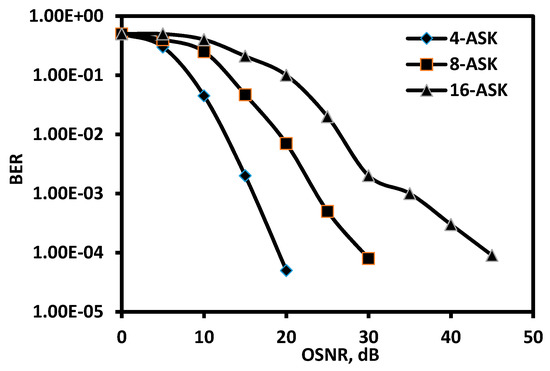
Figure 1.
Optical signal-to-noise ratio (OSNR) vs. bit-error-rate (BER) performance of optical Fast-orthogonal frequency division multiplexing (Fast-OFDM) over an additive white Gaussian noise (AWGN) channel.
3. ANN and IVSTF Nonlinear Equalizers
ANN using nonlinear decision boundaries [21] via the multilayer perceptron has been considered as a promising alternative for combating impairments in wireless communications [22,23]. In ANN, complex mapping between input and output spaces could be achieved, however, at the cost of complexity [14,24]. The proposed ANN for ASK-based optical Fast-OFDM signals reduces the complexity of the equalizer since it processes only amplitude levels and not phase data nor complex data. A schematic diagram is depicted in Figure 2b, in which s(k) FOFDM denotes the training transmitted Fast-OFDM sub-carriers, k (FOFDM refers to Fast-OFDM). The developed NLE using ANN consists of k neural-sub-networks in which the inherent neurons are interconnected with the Fast-OFDM weights values wFOFDM (k,i). The number of neurons in every neural sub-net is proportional to the level of modulation format; for example, it is 16 for 16-ASK. In the output layer, the output signal sums-up all Fast-OFDM neurons . To calculate the error, the minimum mean-square error (MMSE) is estimated, after which the neurons/weights are updated similarly to an adaptive digital filter [14]. Such learning process continues until a very low error value is reached (convergence rate). Equation (1) shows how this error is estimated:

Figure 2.
(a) Optical Fast-OFDM received diagram showing the equalizer that is based on IVSTF [11]. (b) 16-ASK optical Fast-OFDM received diagram illustrating the ANN sub-neural network equalizer. LPF: low-pass filter; ADC: analogue-to-digital converter; CP: cyclic prefix; DCT: Discrete-Cosine Transform; NLE: nonlinear equalizer; ANN: artificial neural network; n: neuron; MMSE: minimum mean square error; HCD: nonlinear system chromatic dispersion.
In Equation (1), is the signal after the training stand can be calculated by the following mathematical formula:
In Equation (2), represents a nonlinear sigmoid “activation function” [14]. It should be also noted that the total number of neurons adopted is also proportional to the number of sub-carriers, as the Fast-OFDM signal consists of (k) number of subcarriers; thus, the ANN equalizer consists of (k) sub-neural networks, each sub-network is designated for a different subcarrier.
The designed ANN for NLE operation in optical Fast-OFDM performs Riedmiller-resilient based back-propagation (RP) [24,25,26,27] for the purpose of updating the weights. The steepest descent algorithm is also used to find a global-data minimization [14]. In ANN numerical demonstration, a differentiable hyperbolic tangent function was employed for the hidden layer (which is only one to further reduce complexity) [26,27] and the linear function “purelin” for the output layer. In Figure 2b the MMSE is processed via the RP algorithm in order for ANN to find the weights that minimize the error in terms of the vectors S(n) FOFDM and FOFDM:
In the developed NLE using ANN the weights are updated according to the five steps presented in [14,26]. Figure 2a, illustrates the benchmark received IVSTF based NLE with identical procedure to [11], which is of deterministic nature since it can tackle deterministic linear and nonlinear crosstalk effects. IVSTF was used as a comparative NLE and it was implemented in time domain in contrast to ANN-NLE, which is processed in frequency domain after the DFCT block. It should be noted that the Volterra-based equalizer is of reduced complexity compared to the well-known full-step digital back propagation [11], using up to 3rd order kernels to account for up to 2nd order chromatic dispersion. The complexity, however, of IVSTF is much higher than ANN since it consists of multiple FFT & IFFT blocks for fiber dispersion and nonlinearity compensation, respectively.
4. Direct-Detected Optical Fast-OFDM System Model Equipped with NLEs and Performance over SMF
The proposed direct-detected optical Fast-OFDM system equipped with either ANN or IVSTF was implemented in a hybrid MATLAB with VPI® simulation platform. Similar equalizers have been previously employed in [11,14], which validates the model used in this work. Moreover, the Fast-OFDM system was modulated using 4-, 8- and 16-ASK signal formats at a signal capacity of 9.69, 14.53 and 19.3 Gb/s, respectively, for both equalizers using 64 sub-carriers and 1000 Fast-OFDM symbols. The transmission-reach of the developed system was set at 640 km (8 spans with a fiber-link length of 80 km). The length of CP was set at 25% to ensure effective elimination of inter-symbol interference [28,29]. At the receiver-end of the simulation set-up a single low pass filter (LPF) unit was employed having 3 dB bandwidth of approximately 3 GHz. For optical amplification per span, Erbium-doped fiber amplifiers (EDFAs) were used having a realistic noise figure of 6 dB.
The sampling rate of the DAC at the transmitter and the ADC at the receiver was chosen at 6.25 GS/s, while the ratio of clipping and quantization bits were optimally set to 7 dB and 10, respectively, which has been reported as the optimum values for high level modulation formats in O-OFDM [6]. The optimum launched optical power for our system under test was found at −6 dBm. A single unit positive-intrinsic-negative (PIN) photo-detector with 0.9 A/W of responsivity was adopted at the receiver-side for direct-detection, while the SMF-transmission-link had the following parameters: 16.9 ps/nm/km fiber dispersion, 0.21 dB/km fiber loss, 0.07 ps/km/nm2 dispersion slope, 0.11 ps/km 0.5 polarization-mode-dispersion coefficient, 2.69 × 10-20 m2/W Kerr-induced nonlinearity coefficient, and 80 μm2 effective core area. The key simulation parameters for the developed ANN-based Fast-OFDM transmission model are depicted in Table 1.

Table 1.
Key optical Fast-OFDM transceiver parameters.
The transmission performance of the direct-detected optical Fast-OFDM system over SMF links for different modulation formats is shown in Figure 3. It is evident from this figure that for a fixed BER at 10−3 (the selected forward-error-correction limit at 10−9) the maximum transmission-reach is at about 380 km, 240 km, and 200 km for 4-, 8- and 16-ASK modulation, respectively. This can be explained by the fact that a higher level of modulation that carry higher data rate increases the SNR on Fast-OFDM sub-carriers, due to the increased amplitude distortions induced by the combined effects of fiber chromatic dispersion and nonlinearity at higher transmission distances.
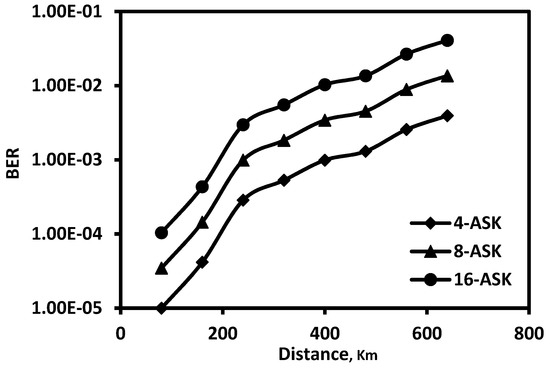
Figure 3.
Optical Fast-OFDM transmission-reach in terms of BER.
5. ANN vs. IVSTF in Direct-Detected Optical Fast-OFDM
The capability of ANN for nonlinearity compensation in optical Fast-OFDM with intensity-modulation and direct-detection is illustrated in Figure 4 in terms of BER vs. distance. In Figure 4, a 4-ASK modulation was considered for simplicity at a signal capacity of 9.69-Gb/s. The optimum transmitted power was found at −6 dBm for ANN-NLE, as well for the benchmark IVSTF and without (W/O) using NLE (i.e., considering only linear equalization). It is revealed from Figure 4 that 160 km extension in transmission-reach is achieved by ANN compared to linear equalization for the adopted BER threshold. In the same manner, 80 km extension in transmission-reach is observed when using ANN compared to the Volterra-based NLE. The latter can be explained by the fact that while IVSTF compensates deterministic intra-channel nonlinearities, ANN can tackle both deterministic and stochastic nonlinearities, i.e., parametric noise amplification from concatenated EDFAs and the interplay between nonlinearity and polarization-mode-dispersion.
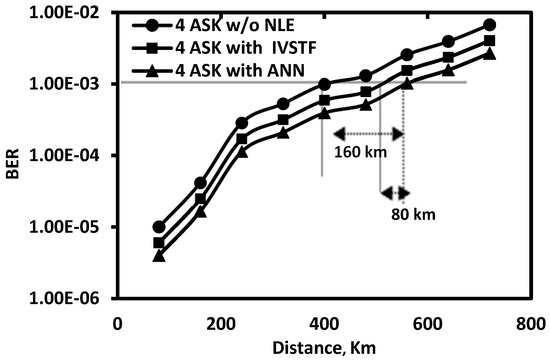
Figure 4.
BER vs. transmission distance for 9.69-Gb/s optical Fast-OFDM at optimum launched optical power of −6 dBm for Volterra-series transfer function (IVSTF)/ANN-NLEs and without (W/O) using NLE.
On the other hand, the performance difference between ANN and linear equalization can be explained in Figure 5, where the BER distribution on the sub-carrier index is depicted. The figure essentially shows that a few Fast-OFDM sub-carriers under ANN equalization have decreased BER (corresponding to increased SNR) compared to linear equalization. This happens because ANN can reduce the effects of inter-carrier four-wave mixing.
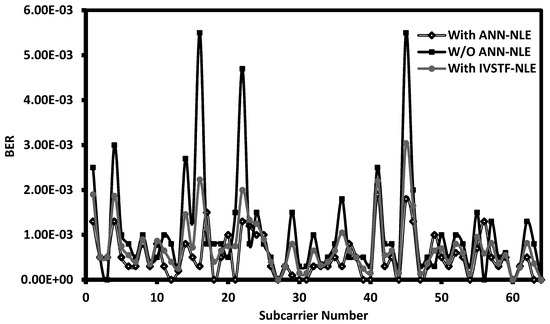
Figure 5.
BER vs. optical Fast-OFDM sub-carrier index, with IVSTF-NLE, ANN_NLE and without utilizing ANN at 320 km of fiber transmission.
Figure 6 depicts the received optical power at the PIN versus the transition distance while adopting the 4-ASK modulation format; it is worth noting that the optical received power values are different at different fiber lengths, varying from −7 dBm for 80 km to −18 dBm for 560 km.
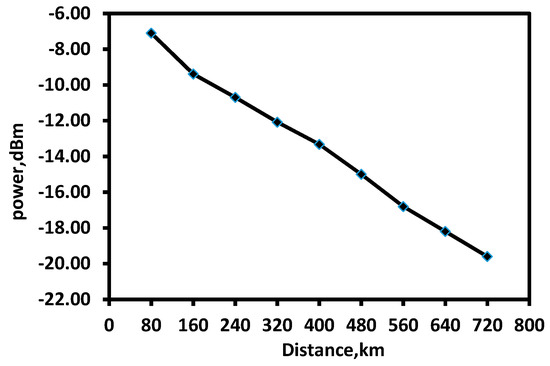
Figure 6.
Received optical power vs. transmission distance for 9.69-Gb/s optical Fast-OFDM without (W/O) using NLE.
Figure 7a shows the effect of the IVSTF and ANN equalizer on the optimum quantization bit. As it can be seen from this figure, utilizing the ANN equalizer relaxes the requirement of a high-resolution DAC/ADC, and reduces the requirement of high quantization bits by 2-bits for the same transmission distance (for the case of 580 km) when compared with case of without equalizer, and by 1 bit when compared with the case of utilizing the IVSTF equalizer. Similarly, this is also applied for the case of clipping ratio, as depicted in Figure 7b: using the established ANN equalizer, an increase in the transmission distance is observed when utilizing the optimum clipping ratio (7 dB); while for a fixed distance of 580 km, a 2-dB reduction in the required clipping ratio is observed when using ANN compared W/O ANN, moreover a reduction of 1 dB when compared with the IVSTF equalizer case.
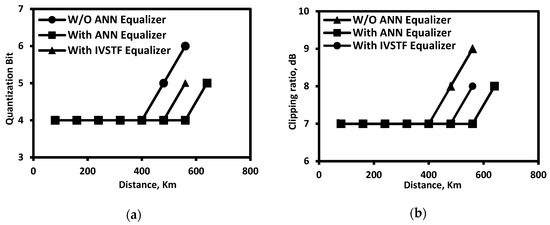
Figure 7.
Effect of DAC/ADC components on 4-ASK optical Fast-OFDM transmission performance with the use of IVSTF equalizer, with ANN equalizer and W/O ANN at a signal bit rate of 9.69-Gb/s for a transmitted power of −6 dBm: (a) Quantization bit vs. Distance. (b) Clipping ratio vs. Distance.
6. Computational Complexity Analysis
When evaluating and comparing equalizers complexity it is essential to take the nature of the equalizer in to considerations, such as the DBP and IVSTF are essentially different from machine learning-based NLEs such as ANN and SVM. That is, as the IVSTF equalization mechanism is based on the idea of reversing of the effect propagation model; consequently, which makes it dependent on the number of fiber spans and the oversampling rate, therefore complexity, does not depend on other signal parameters such as modulation format levels [13].
As the IVSTF equalization is implemented in the hybrid time and frequency domain, it requires several conversions from time to frequency domain and vice versa, which intern makes the complexity depends on the FFT/IFFT pairs that operate on data blocks of size Nblock = K ∗ Nsub, where k is the oversampling constant and Nsub is the number of subcarriers. Consequently, the total number of operations for the IVSTF-based NLE is given by Equation (4), [13]:
On the contrary to IVSTF, ANN based NLEs complexity depends upon some signal parameters, such as the number of modulation forma level and the number of OFDM subcarriers.
The idea behind the ANN concept is based on the imitation of the human brain, as it utilizes a large number of low complexity neurons, which makes their implementation require fewer FLOPs when compared to other approaches like IVSTF. Therefore, the total number of operations performed for processing each Fast OFDM symbol can be obtained by Equation (5) [12,13].
where the , and are the Flop count for input-, output-, and hidden-layers which are illustrated below in Equations (5)–(8) respectively.
where is the number of subcarriers, is modulation format level and is the number of hidden layers.
It is worth noting that in the Fast-OFDM case the complexity is reduced by a factor of two when compared to the conventional Optical-OFDM ANN-NLE case as shown in Equation (9), this is due to the fact that in Optical OFDM signals has real and imaginary components that the ANN-NLE has to deal with, where for the Fast-OFDM case the equalizer only deals with the real data [13].
Below, Figure 8 illustrates a comparison between ANN-NLE and IVSTF-NLE in terms of subcarriers versus Floating points Operations (FLOPs). As the ANN-NLE is a modulation format dependent, therefore, different modulation formats M-ASK (M = 4, 8, and 16) has been used, moreover for the case of number of spans dependent IVSTF-NLE, the modulation formats has been set to 4 ASK, thereafter the number of span has been changed as follow 1 span, 10 spans, and 20 spans.
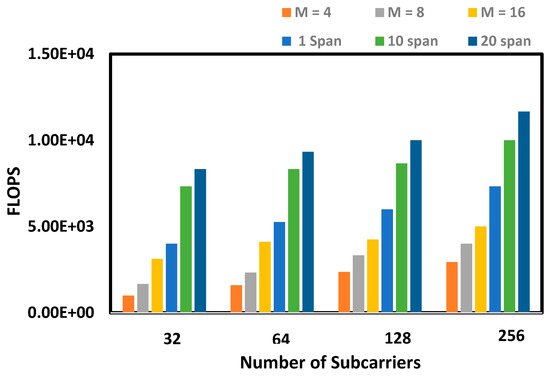
Figure 8.
Computational complexity comparison between ANN-NLE and IVSTF-NLE versus the number of sub carriers, whereas the M-ASK modulation formats (M = 4, 8, and 16) corresponds to the ANN-NLE FLOPS and the 1 span, 10 span and 20 spans corresponds for the IVSTF-NLE FLOPS.
In terms of computational complexity FLOPS, it is shown that for all the number of subcarriers, ANN-NLE outperforms IVSTF-NLE. This is true even, when the best-case scenario of IVSTF-NLE, at 1 span, is compared to the worst-case scenario of ANN-NLE at 16 ASK, while fixing the number of subcarriers. This superiority is due to the utilization of a large number of low complexity neurons, which results in a low computational complexity when compared to the IVSTF-NLE that requires several FFT/IFFT blocks to perform the equalization.
It is worth noting that the proposed nonlinear equalizer can be very useful when applied in cost-sensitive metro-regional and short-reach networks. In future work, ANN-NLE will be implemented in wavelength division multiplexed (WDM) Fast-OFDM signals where IVSTF cannot tackle effectively inter-channel nonlinearities [30].
7. Conclusions
Reduction of intra-channel nonlinearities in low-cost direct-detected optical Fast-OFDM was numerically demonstrated, for the first time, using a low-complex version of an ANN nonlinear equalizer. In contrast to conventional ANN designs for coherent optical OFDM that employs two real-valued activation functions (“split” complex function) to process in-phase and quadrature components separately, here, only amplitude data were processed, thus significantly reducing the computational complexity of the equalizer (e.g., far less neurons were adopted). ANN-NLE proved to be a robust nonlinearity DSP technique for up to 19.37-Gb/s 16-ASKdirect-detected optical Fast-OFDM signals. It was shown that an 80 km extension in transmission-reach was feasible when using ANN compared to the benchmark Volterra-based NLE for 9.69-Gb/s 4-ASK modulated Fast-OFDM sub-carriers. This occurred because ANN can tackle stochastic nonlinear impairments such as parametric noise amplification. Finally, the dynamic parameters requirements of the sub-ranging quantizers were relaxed (DAC/ADC limitations) compared to linear equalization, namely the clipping ratio and quantization bits by 2 dB and 2 bits, respectively moreover 1 dB and 1 bit when compared with the IVSTF NLE performance. Regarding the computational complexity analysis, the ANN-NLE over-performs the back propagation equalizers such as the IVSTF due to the use of low complexity neurons where the IVSTF uses a large number of FFT/IFFT blocks as a part of the equalization process.
Finally, it is worth mentioning that the proposed nonlinear equalizer could be implemented in both state-art-of-the-art optical modems and future super-high-speed optical communication systems, supporting > 40-Gb/s per wavelength. More importantly, due to the low complexity of both Fast-OFDM based DSP and ANN-NLE, the proposed hybrid solution should be more practical for real-time signal processing than benchmark approaches (e.g., conventional optical OFDM and IVSTF or DBP).
Funding
This research received no external funding.
Acknowledgments
I also thank Elias Giacoumidis from Dublin City University for his valuable contributions on the simulation setup and editing.
Conflicts of Interest
The authors declare no conflict of interest.
References
- Jansen, S.L.; Morita, I.; Schenk, C.W.; Takeda, N.; Tanaka, H. Coherent Optical 25.8-Gb/s OFDM Transmission over 4160-km SSMF. IEEE J. Lightw. Technol. 2008, 26, 6–15. [Google Scholar] [CrossRef]
- Pratt, W.K. Laser Communication Systems, 1st ed.; John Wiley & Sons: New York, NY, USA, 1969. [Google Scholar]
- Li, K.; Darwazeh, I. System performance comparison of Fast-OFDM with overlapping MC-DS-CDMA and MT-CDMA systems. In Proceedings of the 6th International Conference on Information, Communications & Signal Processing, Singapore, 10–13 December 2007; pp. 1–4. [Google Scholar]
- Ibrahim, S.K.; Jian, Z.; Rafique, D.; O’Dowd, J.A.; Ellis, A.D. Demonstration of world-first experimental optical Fast OFDM system at 7.174 Gbit/s and 14.348 Gbit/s. In Proceedings of the European Conference and Exhibition on Optical Communication (ECOC), Torino, Italy, 19–23 September 2010; pp. 1–3. [Google Scholar]
- Zhao, J.; Ibrahim, S.K.; Rafique, D.; Gunning, P.; Ellis, A.D. Symbol synchronization exploiting the symmetric property in optical Fast OFDM. IEEE Photonics Technol. Lett. 2011, 23, 594–596. [Google Scholar] [CrossRef]
- Giacoumidis, E.; Tsokanos, A.; Mouchos, C.; Zardas, G.; Alves, C.; Wei, J.L.; Tang, J.M.; Gosset, C.; Jaouën, Y.; Tomkos, I. Extensive comparisons of optical Fast-OFDM and conventional optical OFDM for local and access networks. J. Opt. Commun. Netw. 2012, 4, 724–733. [Google Scholar] [CrossRef]
- Jarajreh, M.A.; Ghassemlooy, Z.; Ng, W.P. Improving the chromatic dispersion tolerance in long-haul fibre links using the coherent optical orthogonal frequency division multiplexing. IET Microw. Antennas Propag. 2010, 6, 651–658. [Google Scholar] [CrossRef]
- Gao, G.; Zhang, J.; Gu, W. Analytical Evaluation of Practical DBP-Based Intra-Channel Nonlinearity Compensators. IEEE Photonics Technol. Lett. 2013, 25, 717–720. [Google Scholar] [CrossRef]
- Liu, L.; Li, L.; Huang, Y.; Cui, K.; Xiong, Q.; Hauske, F.N.; Xie, C.; Cai, Y. Intrachannel Nonlinearity Compensation by Inverse Volterra Series Transfer Function. IEEE J. Lightw. Technol. 2012, 30, 310–316. [Google Scholar] [CrossRef]
- Lowery, A.J. Fiber nonlinearity pre- and post-compensation for long-haul optical links using OFDM. Opt. Exp. 2007, 15, 12965–12970. [Google Scholar] [CrossRef]
- Giacoumidis, E.; Aldaya, I.; Jarajreh, M.A.; Tsokanos, A.; Le, S.T.; Farjady, F.; Ellis, A.D.; Doran, N.J. Volterra-based Reconfigurable Nonlinear Equalizer for Dual-Polarization Multi-Band Coherent OFDM. IEEE Photonics Technol. Lett. 2014, 26, 1383–1386. [Google Scholar] [CrossRef]
- Giacoumidis, E.; Mhatli, S.; Nguyen, T.; Le, S.; Aldaya, I.; Ellis, A.; Mccarthy, M.; Eggleton, B. Comparison of DSP-based nonlinear equalizers for intra-channel nonlinearity compensation in coherent optical OFDM. Opt. Lett. 2016, 41, 2509–2512. [Google Scholar] [CrossRef]
- Giacoumidis, E.; Lin, Y.; Wei, J.; Aldaya, I.; Tsokanos, A.; Barry, B. Harnessing machine learning for fiber-induced nonlinearity mitigation in long-haul coherent optical OFDM. Future Internet 2019, 11, 2. [Google Scholar] [CrossRef]
- Jarajreh, M.A.; Giacoumidis, E.; Aldaya, I.; Le, S.T.; Tsokanos, A.; Ghassemlooy, Z.; Doran, N.J. Artificial neural network nonlinear equalizer for coherent optical OFDM. IEEE Photonics Technol. Lett. 2015, 27, 387–390. [Google Scholar] [CrossRef]
- Zhao, J. Multi-Tap Equalization for Performance Improvement in Optical Fast OFDM Systems. IEEE Photonics Technol. Lett. 2015, 27, 42–45. [Google Scholar] [CrossRef]
- Zidan, M.; Abdel-Aty, A.; El-shafei, M.; Feraig, M.; Al-Sbou, Y.; Eleuch, H.; Abdel-Aty, M. Quantum Classification Algorithm Based on Competitive Learning Neural Network and Entanglement Measure. Appl. Sci. 2019, 9, 1277. [Google Scholar] [CrossRef]
- Walczak, S. An empirical analysis of data requirements for financial forecasting with neural networks. J. Manag. Inf. Syst. 2001, 17, 203–222. [Google Scholar]
- Yue, F.; Chai, T. Neural-network-based nonlinear adaptive dynamical decoupling control. IEEE Trans. Neural Netw. 2007, 18, 921–925. [Google Scholar] [CrossRef] [PubMed]
- Mellit, A.; Eleuch, H.; Benghanem, M.; Elaoun, C.; Massi Pavan, A. An adaptive model for predicting of global, direct and diffuse hourly solar irradiance. Energy Convers. Manag. 2010, 51, 771–782. [Google Scholar] [CrossRef]
- Nsiri, B.; Mhatli, S.; Mallouki, N.; Ghanbarisabagh, M.; Giacoumidis, E.; Ammar, M.; Bouallègue, A.; Attia, R. Nonlinearity mitigation of optical Fast-OFDM signals using a Wiener-Hammerstein electrical equalizer. In Proceedings of the Science and Information Conference (SAI), London, UK, 28–30 July 2015; pp. 1056–1061. [Google Scholar]
- Savazzi, P.; Favalli, L.; Costamagna, E.; Mecocci, A. A suboptimal approach to channel equalization based on the nearest neighbor rule. IEEE J. Sel. Areas Commun. 1998, 16, 1640–1648. [Google Scholar] [CrossRef]
- Rajbhandari, S.; Ghassemlooy, Z.; Angelova, M. Effective denoising and adaptive equalization of indoor optical wireless channel with artificial light using the discrete wavelet transform and artificial neural network. IEEE J. Lightw. Technol. 2009, 27, 4493–4500. [Google Scholar] [CrossRef]
- Charalabopoulos, G.; Stavroulakis, P.; Aghvami, A.H. A frequency-domain neural network equalizer for OFDM. In Proceedings of the GLOBECOM, San Francisco, CA, USA, 1–5 December 2003; pp. 571–575. [Google Scholar]
- Giacoumidis, E.; Ibrahim, S.K.; Zhao, J.; Wei, J.L.; Tang, J.M.; Ellis, A.D.; Tomkos, I. Effect of ADC on the Performance of Optical Fast-OFDM in MMF/SMF-Based Links. In Proceedings of the Electromagnetics Research Symposium (PIERS), Suzhou, China, 12–16 September 2011; pp. 402–406. [Google Scholar]
- Riedmiller, M.; Braun, H.A. Direct adaptive method for faster backpropagation learning: The RPROP Algorithm. In Proceedings of the IEEE International Conference on Neural Networks (ICNN), San Francisco, CA, USA, 28 March–1 April 1993; pp. 586–591. [Google Scholar]
- Chen, E.; Tao, R.; Zhao, X. Channel equalization for OFDM system based on the BP Neural network. In Proceedings of the IEEE International Conference on Signal Processing (ICSP), Beijing, China, 16–20 November 2006. [Google Scholar]
- Benvenuto, N.; Piazza, F. On the complex backpropagation algorithm. IEEE Trans. Signal Proc. 1992, 40, 967–969. [Google Scholar] [CrossRef]
- Giacoumidis, E.; Wei, J.L.; Yang, X.L.; Tsokanos, A.; Tang, J.M. Adaptive modulation-enabled WDM impairment reduction in multi-channel optical OFDM transmission systems for next generation PONs. IEEE Photonics 2010, 2, 130–140. [Google Scholar] [CrossRef]
- Giacoumidis, E.; Jarajreh, M.A.; Sygletos, S.; Le, S.T.; Tsokanos, A.; Hamié, A.; Pincemin, E.; Jaouën, Y.; Farjady, F.; Ellis, A.D.; et al. Dual-polarization multi-band OFDM transmission and transceiver limitations for up to 500 Gb/s in uncompensated long-haul links. Opt. Exp. 2014, 22, 10975–10986. [Google Scholar] [CrossRef]
- Giacoumidis, E.; Le, S.T.; Aldaya, I.; Wei, J.L.; McCarthy, M.E.; Doran, N.J.; Eggleton, B.J. Experimental Comparison of Artificial Neural Network and Volterra based Nonlinear Equalization for CO-OFDM. In Proceedings of the OSA Optical Fiber Communication Conference and Exposition and the National Fiber Optic Engineers Conference (OFC/NFOEC), San Francisco, CA, USA, 20–24 March 2016. [Google Scholar]
© 2019 by the author. Licensee MDPI, Basel, Switzerland. This article is an open access article distributed under the terms and conditions of the Creative Commons Attribution (CC BY) license (http://creativecommons.org/licenses/by/4.0/).